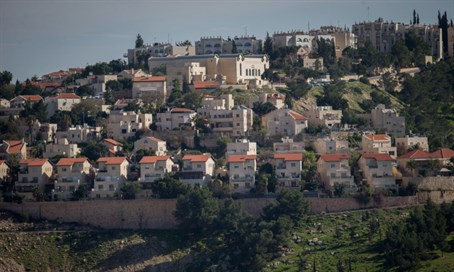 The New York Times and one Ian Fisher made a mistake today. They decided to publish an article about Ma’ale Adumim without actually bothering to understand much of the story they were writing. Blinded to their own agenda, the article is filled with errors that show much more about the New York Times than about my little city of Ma’ale Adumim.
The New York Times and one Ian Fisher made a mistake today. They decided to publish an article about Ma’ale Adumim without actually bothering to understand much of the story they were writing. Blinded to their own agenda, the article is filled with errors that show much more about the New York Times than about my little city of Ma’ale Adumim.
It’s a toss-up whether it is better to focus on correcting the errors or offering a complete rewrite to a hopelessly inaccurate article. But, I want to help Ian out here, so here goes:
Title: Israel’s Hard-Liners Want to ‘Go Big’: Annex a Settlement
The title states that Israel’s hard liners want to annex a settlement. Actually, in legal terms, it is a city. And we don’t actually want (or need) to annex it. We simply are seeking to extend civil law of Israel to our city as well. For basic reasons. For example, all of Israel has converted to a new system whereby large chain stores no longer give out plastic bags. It’s a step for improving the environment, something Israel is very keen and focused on. So, we are all carrying around these large pink or green or yellow reusable bags rather than spending 10 agurot to purchase one-time plastic bags. The collected monies will be given to the government to spend on ecological programs. Only the stores located in our area didn’t realize that this new civil law doesn’t apply to Ma’ale Adumim and other areas in Judea and Samaria and so here we are, buying these bags and the chain stores have no legal means for donating the money because they aren’t legally required to charge. We are a city in every way, like any other and yet the laws we live by are different because we are located 5 kilometers to the east of Jerusalem instead of 5 kilometers to the west. It is absurd that we are denied so many things and yet pay our taxes, serve in the army, vote in every election, and are an integral part of Israel as a nation.
The first babies of Ma’ale Adumim, a hilly city on the eastern outskirts of Jerusalem, are now middle-aged. A cemetery finally opened last year, and 40 residents are buried there, most dead of natural causes after long and peaceful lives.
Well, Ian writes that most of the dead who are buried in our new cemetery died of “natural causes after long and peaceful lives.” Perhaps I am reading into it, but when you say “most,” you imply that some didn’t – otherwise why not say “all.” To the best of my knowledge, there is one young woman, a soldier, who died in a bus accident. And that’s it. I guess that can’t be called “natural” or “long” but certainly includes a bit of nitpicking on dear Ian’s part.
…there is nothing temporary about this place, one of the closest settlements to Jerusalem in the occupied West Bank, which Israel seized from Jordan 50 years ago.
First, Ian writes that we “seized” the land from Jordan 50 years ago. Actually, Ian, Jordan attacked us. We didn’t “seize” anything. We beat their army back and for the most part, they ran back to Jordan as fast as they could. What you didn’t write is what Jordan did during the 19 years they occupied this land. They didn’t create a Palestinian state, and they didn’t allow Jews the freedom of visiting their holiest of sites. One has to wonder what Ian said to Sima Weiss, 58-year-old resident of Ma’ale Adumim to get her to say defensively “I don’t feel like a settler.” But Ian doesn’t tell us that.
The world has focused more critically recently on Israel’s settlements in occupied territory, after last month’s United Nations declaration — which the United States tacitly supported — that they are killing the dream of one state for Jews, one for Palestinians.
Well, this is clearly slanted to show his opinion but what is interesting here are two things. 1) the phrasing “the world has focused more critically recently on Israel’s settlements” – as if they gave us a free pass before? 2) reference to a UN declaration (Resolution 2334) that the US tacitly supported Israel killing the two state solution (and I like how he puts a link in for “Palestinians” but not for “Jews.”
Many Israelis argue that Ma’ale Adumim — a city of 41,000 with filled schools, a largely secular civic pride and skittish stray cats — is a special case.
Here, Ian states that “many Israelis argue that Ma’ale Adumim…is a special case.” Isn’t it funny how Ian uses the word “most” about dead people when he should have written “nearly all” and here, he uses the world “many” when in fact, in a recent poll it was found that at least 78% of Israelis support a “unilateral annexation” of Ma’ale Adumim (according to the Jerusalem Post). I can’t say that 78% is anything less than most, and it certainly isn’t “many.” By the way, Ian, why don’t you like our cats?
Right-wing politicians, emboldened by a more sympathetic Trump administration, want to annex it to Israel proper — the first formal annexation of a settlement.
Round about here, you wish Ian would just stop, but no, he continues with his incorrect nuances. He says that right-wing politicians have been “emboldened by a more sympathetic Trump administration” and therefore seek to “annex it to Israel proper”. So, Ian, that annexation project has been going on for many months – long before Trump was elected. And that concluding sentence, that in the absence of negotiations, “Ma’ale Adumim would likely be a part of Israel in any case.” So Ian, first, Maale Adumim is ALREADY part of Israel and second, there is no “likely”. The opinion that Ma’ale Adumim will remain part of Israel in any long-term agreement is something that is almost universally accepted, not just in Israeli society, but even among European and American leaders. You’re not going to be moving this city anywhere.
Then there’s a really nice picture of a kid and a dog on a pretty balcony facing Jerusalem, which, Ian and the photographer, one Dan Balilty, rush to remind you, is in the “occupied West Bank.” Yeah, not.
Further down is another picture, this time of Palestinian laborers building in Ma’ale Adumim. Interestingly enough, there are no slave drivers next to them, no people holding whips. The workers are not in chains. No one is forcing them to work and they likely earn at least double what they could earn if they worked in the neighborhoods where they live. Ian mentions that these workers are building one of an allocated 100 new units. One hundred new apartment for a city with over 40,000 people is ridiculous. That’s not even to the level of natural growth.
One issue with Ma’ale Adumim, critics argue, is its place in the West Bank, between north and south, that combined with other building plans could both hamper transit of Palestinians and threaten the contiguous borders of any future Palestinian state.
Anyone who has ever visited Ma’ale Adumim or the Dead Sea knows that a major highway goes from Jerusalem to the Dead Sea. It is used by Palestinians and Israelis on a daily basis. No one has any plans to “hamper transit of Palestinians” because that would be geographically impossible without cutting off Ma’ale Adumim residents who use the same road. If anything, it is Ma’ale Adumim that has been cut off several times by violence. In the first intifada, our residents were regularly attacked while traveling to Jerusalem and so the country built a by-pass road so that we didn’t have to travel through Abu Dis and Azariya, two predominantly Arab neighborhoods. A few years ago, when they by-pass road came under attack (washing machines, couches, flaming tires and boulders thrown off the cliff at Israeli motorists and one monk from near Jericho was shot and murdered by Palestinian terrorists), Israel built a by-pass to the by-pass road, which now regularly comes under attack as well. So if anyone’s “transit” is being hampered, it is ours and not theirs.
Eid Abu Khamis, the leader of some 8,000 Bedouins in the area, says harassment by Israel has increased recently. More of their makeshift housing has been torn down and land for their goats and sheep — they sell meat, yogurt and cheese to survive — declared off-limits.
Most of the Bedouins live in the E1 area, which is technically a part of Ma’ale Adumim and is slated for some 3,700 new housing units. The Obama administration staunchly opposed any development in E1 as a possible point of no return for a viable Palestinian state.
Okay, I live here. There aren’t 8,000 Bedouins living in E1. There MIGHT be 8,000 living between Ma’ale Adumim and the Dead Sea, in small clusters of tents and illegally built structures (thank you to the UN for those), and wooden and metal boards strapped and nailed together with nearby pens built for their sheep, but on E1, no way. In fact, short of a group of under 100, there are no Bedouins living on the small hill known as E1, which geographically covers a grand total of, can you imagine, 12 square kilometers (Wikipedia). What Ian is probably doing to come up with this number, is including at least one clan that actually lives clear on the other side of Ma’ale Adumim and has nothing to do with E1 at all.
Palestinian children playing in the street Sunday in the E1 section of Ma’ale Adumim, an especially contentious area where some 8,000 Bedouins live. It is slated for some 3,700 new housing units.
Below this section is a picture of some Arab children “playing in the street…in the E1 section of Ma’ale Adumim.” Ian, Ian, Ian…the only building on E1 is a very large police station (I went there once to file a report with the local police after an Arab man ran a red light and totaled my two month old car, sending me to the hospital).
You can actually see E1 in the distance behind this neighborhood, which I would guess is Azariya. Maybe 8,000 Bedouins that Ian cited earlier (and again here in case you missed the first time he made this error) live in Azariya, but I don’t think so because, as you can see from the picture, people in Azariya live in homes. With walls. Including the one that has a really interesting picture on it. A g un, shooting a missile or bullet at a heart.
un, shooting a missile or bullet at a heart.
I guess the residents either love their guns or believe guns can kill love? I don’t know. I’m not an expert on Palestinian graffiti.
“If the Bedouin are kicked out of this land where we have lived for 30 years, it will be the end of negotiations with the State of Israel,” Mr. Khamis said.
Now this is interesting. Ian confirms that Maale Adumim is 40 years old but somehow implies that these Bedouin’s, including Mr. Khamis, has more right to be here, having come here 30 years ago. So clearly, he isn’t Jordanian and clearly he isn’t Israeli so does that mean he is trying to seize the land from us? Ian doesn’t say.
Many Palestinians argue that the annexation could ignite another round of violent revolt. A Palestinian flag was recently planted in a park in Ma’ale Adumim here, a worrying sign for residents that the less expensive, less harried life in their suburb may change.
I’m not sure which point to address first – that another round of violence could be ignited? Doesn’t that imply that the last one ended? When exactly did that happen? As for the planted Palestinian flag…no one here considers that a worrying sign at all. More likely, it was, if anything, kids playing. And if it was a Palestinians who “planted” the flag (by this I assume Ian means stuck it in the ground and ran), I hope he didn’t kill any of our beautiful flowers.
“I didn’t come because I believe we should take all the land between the Mediterranean and the Jordan River,” said a 71-year-old resident, a driver who would give his name only as Max S. “It was cheap. That’s why I came. If I could change my apartment to an apartment in Tel Aviv, in a minute I would do it. “
Congratulations to Ian for finding an Israeli with brains. If I could change my beautiful home, which I love dearly, for an apartment or similar-sized home in Tel Aviv, I would do it in a minute too! Then I’d sell the house in Tel Aviv and buy two houses here in Ma’ale Adumim. Welcome to real estate in Israel. By the way, few people would call land or homes in Ma’ale Adumim cheap. To give you some comparison, my home would sell for about $900,000.
I believe in giving credit where credit is due and so I commend Ian on this next paragraph, probably the only one I could find without a hidden agenda and garbled facts:
People here are proud of what they have built since it was founded in 1975, with 15 religious Jews. There is a library, a theater, 15 schools and 78 kindergartens. It is mostly secular, but gets along with its more religious residents, about a quarter of the population. An industrial park, while the occasional target of the worldwide campaign to boycott goods made in settlements, is thriving and employs some 4,000 Palestinians — at much higher wages, the mayor notes, than they could earn in Palestinian areas.
Though he did forget the country club with three very nice pools, the music conservatory, the museum, and the bowling alley.
Then there’s a picture. An Ethiopian Israeli looking, according to Ian “over Ma’ale Adumim last week.” I actually know the man and the place…my daughter lives very close to there. Actually, he’s looking towards E1 and an Arab neighborhood to the left of him, although Ma’ale Adumim can be seen to his immediate left and behind him.
For a great article on this, by the way, check out Caroline Glick’s sound and sane (and properly cited) post.



